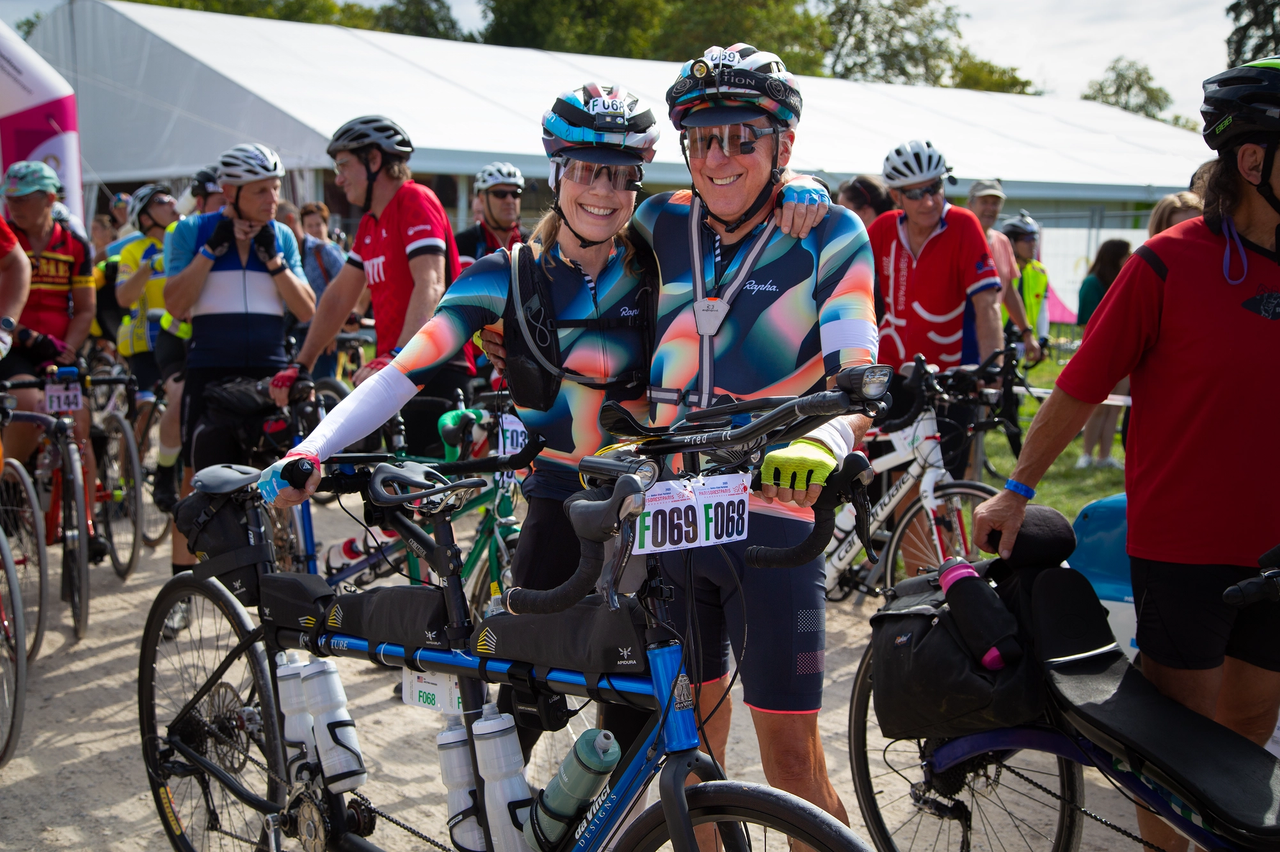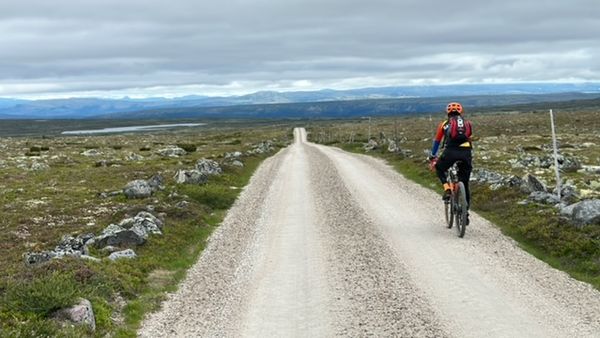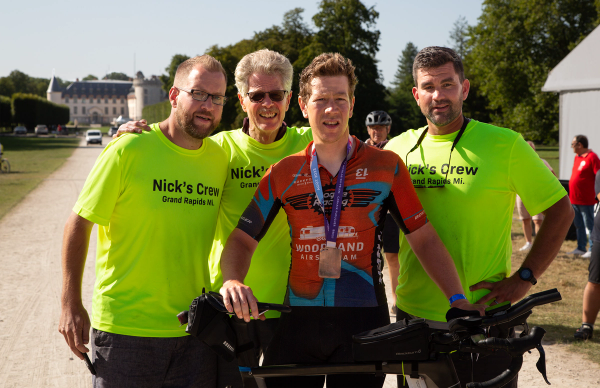From catastrophe to victory: the fastest tandem at Paris-Brest-Paris
John and Ann Jurczynski have dominated the tandem category at Paris-Brest-Paris since 2015, but in 2021, a life-threatening crash put it all in the balance
James Howell-Jones
Junior Writer
© GCN
Ann and John Jurczynski at the start of Paris-Brest-Paris 2023
Paris-Brest-Paris might not, technically, be a ‘race’, but there’s no getting away from the fact that John and Ann Jurczynski have dominated the tandem category since they first took their place on the start line in 2015. That year, they were almost 17 hours ahead of their nearest rival.
At the next edition in 2019, they were eight hours ahead of the field. This year, they scored the hat-trick, again coming in eight hours ahead of the nearest tandem pair. They’ve proved, again and again, that regardless of their age - John and Ann are 66 and 59 respectively - they’re one of the most effective tandem teams in the world.
GCN caught up with the pair a few hours before the start of Paris-Brest-Paris 2023. Reclined in a deep outdoor sofa outside their hotel, their cheeks still glowing from a splendid continental breakfast, John and Ann sat with a quiet sense of confidence and ease. The scene was so relaxed and comfortable, it was hard to imagine that in a few hours, and for the next few days and nights, their sole front light would cast its harsh beam through the dark plains of northern France, night after night, as they rode through pain, exhaustion and hunger.
Only when they began to talk did you get a sense of what John and Ann are capable of. During our conversation, glimmers emerged of that streak that separates ultra-endurance athletes from the rest of us. They might have looked perfectly harmless as we sat around sipping coffee, but these two riders have an unshakeable drive, forged through storied lives. For John and Ann, ultra-distance cycling is their way of living life on their own terms, and besides broken bones, few things will keep them from pedalling.
Busy lives and interrupted passions
Ann and John spend more time in the saddle than most professional cyclists, and log thousands upon thousands of miles a year. Their success in ultra-cycling and randonneuring comes from the fact that, quite simply, they refuse to stop riding. Who can blame them? After each leading their own lives, complete with the usual distractions we all face, the pair are determined to ride.
John was once a dedicated touring cyclist: “In my early twenties, I bicycled across the US three different times and camped and just loved it.”
In fact, John even had his eye on the trans-America record. When he saw the record set by John Marino, he thought, says John, “maybe I could do something like that.”
Alas, his ultra-distance ambitions were sidelined. It’s a familiar story: “Life kinda gets in the way”, says John. “I got married, had a child, and 25 years passed”.
Only in his 50s did John start riding long distances again. He took part in some local long-distance events, and was surprised to find he’d still retained something of his form. “I ended up staying with the leaders, and I rode well, and then I said, ‘ok, maybe I have a knack for this.’” John’s love of ultra-distance was reignited.
Ann spoke less readily about her past, but it’s clear that she relishes the freedom that ultra-distance riding presents. For her, events like Paris-Brest-Paris are opportunities to ride uninterrupted: “I like to ride every day. So [Paris-Brest-Paris] is just kind of like, ‘okay, I'm gonna ride today.’ Then, ‘Oh! I get to ride tonight!’ And I actually love that.” Ann has come to cycling from the elite world of Nordic skiing, having been part of the Fischer Salomon Marathon ski team. Like John, she’s had her own life, family and career. Now, she’s a total convert to cycling, saying, “I love to train. I love to ride.”
The pair met in 2014. After getting to know each other a little at a local time trial, John saw Ann out riding one day and had a brainwave: “It gave me the idea to email her and say, ‘Hey, do you have any interest in this crazy randonneuring sport, and maybe riding Paris-Brest-Paris?’ And she wrote back in capital letters: ‘YES’. And that’s how it all started.” They began training together, and just a year later, rode Paris-Brest-Paris, finishing the 1,200km course in a remarkable 51 hours, 48 minutes.
They returned to Paris-Brest-Paris in 2019, now a married couple, and logged another remarkable performance. Now, John and Ann spend every day of their retirement riding their local roads in Maine, USA on their Davinci Joint Venture tandem. A hundred kilometres or so is a typical daily ride, usually taken early in the morning, but they often go further, and regularly take part in randonneuring events across the country.

© GCN
John and Ann Jurczynski in Rambouillet, France
The crash
With every distraction and barrier behind them, the unstoppable duo were going from strength to strength. But then, in 2021, a catastrophic crash threatened to put an end to everything.
“Two years ago we had a horrible accident,” John explained. “Our front fork collapsed and we were riding pretty hard. I landed on my head. We both landed on our heads. We cracked our helmets; Ann broke her hand, and I broke my neck and my back. So at the time, I wasn't sure if I was gonna be paralyzed, if I was gonna be able to ride a bike again.”
Just like that, John exchanged the leafy countryside of New England for the cold, white walls of a hospital. Thankfully, his nervous system was intact, and following surgery, he began the long road to recovery. For nine months, John was unable to ride. Even now, two years later, his neck mobility is limited. In spite of everything, though, the tandem team wanted to get back on their bike, and get riding. They tested all kinds of bikes to find something comfortable for John. In the end, they found a normal, upright tandem was best.
The next obstacle was overcoming the trauma from the accident.
“We were both terrified of getting an upright bike, because we're looking at people riding bikes, like, ‘that's dangerous, that fork's gonna fail on you.’ We just had that in our head, and it took us about a year to feel comfortable again to ride a regular bike,” John says.
Nonetheless, and true to form, the pair got riding again. Month by month, they built up their mileage, and soon they began to tackle the qualifying events for Paris-Brest-Paris – to get a place on the start line in Rambouillet, each rider must have completed a 200km, 300km, 400km and 600km brevet.
“So, for us, this time around is more monumental just to be here than it has been in the previous years, just because of the obstacles we’ve had to overcome.”
Riding through adversity
John and Ann’s appetite for miles is insatiable. Most participants clock up about 8,000km in the seven months of the year preceding Paris-Brest-Paris, a substantial distance for any cyclist. John and Ann, meanwhile, arrived at this year’s brevet with almost 23,000km in the legs. One gets the sense that they’re riding to make up for lost time, be that from the accident or the years before they met. They are determined to let nothing keep them from pedalling. As Ann says, “I would rather not ride in a train or a car or anything, so I do whatever I can to avoid getting off my bike.”
Of course, to ride as they do, day after day and night after night, both are intimately familiar with suffering. In fact, for experienced endurance athletes like these two, the hardship is part of the fun. When asked what she loved about ultra cycling, Ann said that she loved “how difficult it gets”. Much like real life, ultra-distance riding is full of ups and downs. Ann spoke of the satisfaction of getting through the tough moments: she loves “how you have to get through them and how you can feel successful.”
Really, though, as John nicely puts it, the hardest part has been getting here, and anything that happens out on the course is easy by comparison: “Once you actually start pedalling, it's this huge relief. It's just like, ‘okay, I'm just doing what I want to do now.’ So you've done the hard bit. The hard bit, really, is getting to the starting line.”
John’s referring first and foremost to their recent crash, their road to recovery, and to the nightmare logistics of getting everything they need for Paris-Brest-Paris across the atlantic. More broadly, though, when John says the hard part is behind them, he’s referring to a lifetime of deviations and distractions. They’ve done the work, and built a lifestyle that allows them to travel the world, excelling at what they do.










